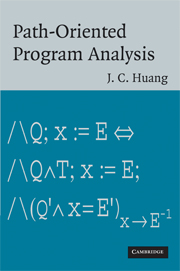Aho, A. V., Sethi, R., and Ullman, J. D., Compilers: Principles, Techniques, and Tools, Addison-Wesley, Reading, MA, 1986.
Aho, A. V. and Ullman, J. D., The Theory of Parsing, Translation, and Compiling, Vol. II: Compiling, Prentice-Hall, Englewood Cliffs, NJ, 1973.
Aiken, A., “Introduction to set constraint-based program analysis,” Science of Computer Programming 35, (2–3), 79–111, 1999.
Ammons, G. and Larus, J. R., “Improving Data-Flow Analysis with Path Profiles,” Proceedings of the ACM SIGPLAN 1998 Conference on Programming Language Design and Implementation, Montreal, Quebec, 1998, 72–84.
Amtoft, T., Nielson, F., and Nielson, H. R., Type and Effect Systems: Behaviours for Concurrency, World Scientific, Singapore, 1999.
Anderson, R. B., Proving Programs Correct, John Wiley & Sons, New York, NY, 1979.
Charniak, E. and McDermott, D., Introduction to Artificial Intelligence, Addison-Wesley, Reading, MA, 1985, p. 147.
Cousot, P. and Cousot, R., “Abstract interpretation: A unified lattice model for static analysis of programs by construction or approximation of fixpoints,” in the Proceeding of the ACM Symposium on Principles of Programming Languages, Association for Computing Machinery, New York, NY, 1977, pp. 238–52.
Dijkstra, E. W., “Guarded commands, nondeterminancy and formal derivation of programs,” Communications of the ACM 18, 453–7, 1975.
Dijkstra, E. W., A Discipline of Programming, Prentice-Hall, Englewood Cliffs, NJ, 1976.
Flanagan, C. and Qadeer, S., “A type and effect system for atomicity,” ACM SIGPLAN Notices 38, 338–49, 2003.
Fosdick, L. D. and Osterweil, L. J., “Data flow analysis in software reliability,” ACM Computing Surveys 8, 305–30, 1976.
Gehani, N., ADA: An Advanced Introduction, Prentice-Hall, Englewood Cliffs, NJ, 1983.
Howden, W. E. and Eichhorst, P., “Proving properties of Programs from program traces,” CS Report #18, University of California at San Diego, 1977.
Huang, J. C., “A new verification rule and its applications,” IEEE Transactions on Software Engineering SE6, 480–4, 1980a.
Huang, J. C., “Instrumenting programs for symbolic-trace generation,” Computer 13, 17–23, 1980b.
Huang, J. C., “State constraints and pathwise decomposition of programs,” IEEE Transactions on Software Engineering 16, 880–96, 1990.
Huang, J. C. and Leng, T., “Generalized loop-unrolling: A method for program speedup” in Proceedings of the 1999 IEEE Workshop on Application-Specific Software Engineering and Technology, IEEE, 1999, pp. 244–8.
Johnsonbaugh, R. and Kalin, M., Application Programming in C++, Prentice-Hall, Englewood Cliff, NJ, 1999.
Jones, N. D. and Nielson, F., “Abstract interpretation: A semantics-based tool for program analysis,” in Handbook of Logic in Computer Science, Vol. 4: Semantic Modeling, Oxford University Press, New York, NY, 1995.
Jalote, P., Vangala, V., Singh, T., and Jain, P., “Program partitioning: A framework for combining static and dynamic analysis,” in Proceedings of the 2006 International Workshop on Dynamic Systems Analysis, ACM Press, 2006, pp. 11–16.
Khurshid, S., Pǎsǎreanu, C. S., and Visser, W., "Generalized symbolic execution for model checking and testing," In H. Garavel and J. Hatcliff, editors, Tools and Algorithms for the Construction and Analysis of Systems, 9th International Conference, TACAS 2003, Held as Part of the Joint European Conferences on Theory and Practice of Software, ETAPS 2003, Warsaw, Poland, 2003, Proceedings, volume 2619 of Lecture Notes in Computer Science, Springer, 2003.
King, J. C., “A new approach to program testing,” in Proceeding of the 1975 International Conference on Reliable Software, ACM Press, 1975.
King, J. C., “Symbolic Execution and Program Testing,” Communications of te ACM 19, 385–94, 1976.
Leler, W., Constraint programming languages: Their specification and generation, Addison-Wesley, Reading, MA, 1988.
Leng, T., Program Speedup Through Generalized Loop Unrolling: Practical Aspects, Ph.D. dissertation, Department of Computer Science, University of Houston, Houston, TX, 2001.
Lunts, A. G., “A method of analysis of finite automata,” Soviet Physics – Doklady 10, 102–3, 1965.
Manna, Z., Mathematical Theory of Computation, McGraw-Hill, New York, NY, 1974.
McCabe, T. J., “A complexity measure,” IEEE Transactions on Software Engineering SE2, 308–20, 1976.
Nielson, F., Nielson, H. R., and Hankin, C., Principles of Program Analysis, 2nd ed., Springer-Verlag, New York, NY, 2005.
Prata, S., C++ Primer Plus, 5th ed., Sams Publishing, Indianapolis, 2005.
Stucki, L. G., “Automatic generation of self-metric software,” in Proceedings of the IEEE Symposium on Computer Software Reliability, IEEE, New York, NY, 1973, pp. 94–100.
Weiser, M., “Program Slicing,” IEEE Transactions on Software Engineering, SE-10, 1984, 352–7.
WIKIPEDIA: The Internet free encyclopedia, available at http://en.wikipedia.org.
Yeh, R. T., “Verification of programs by predicate transformation,” in Current Trends in Programming Methodology, Vol. II: Program Validation, Prentice-Hall, Englewood Cliffs, NJ, 1977, pp. 228–47.



 Loading metrics...
Loading metrics...